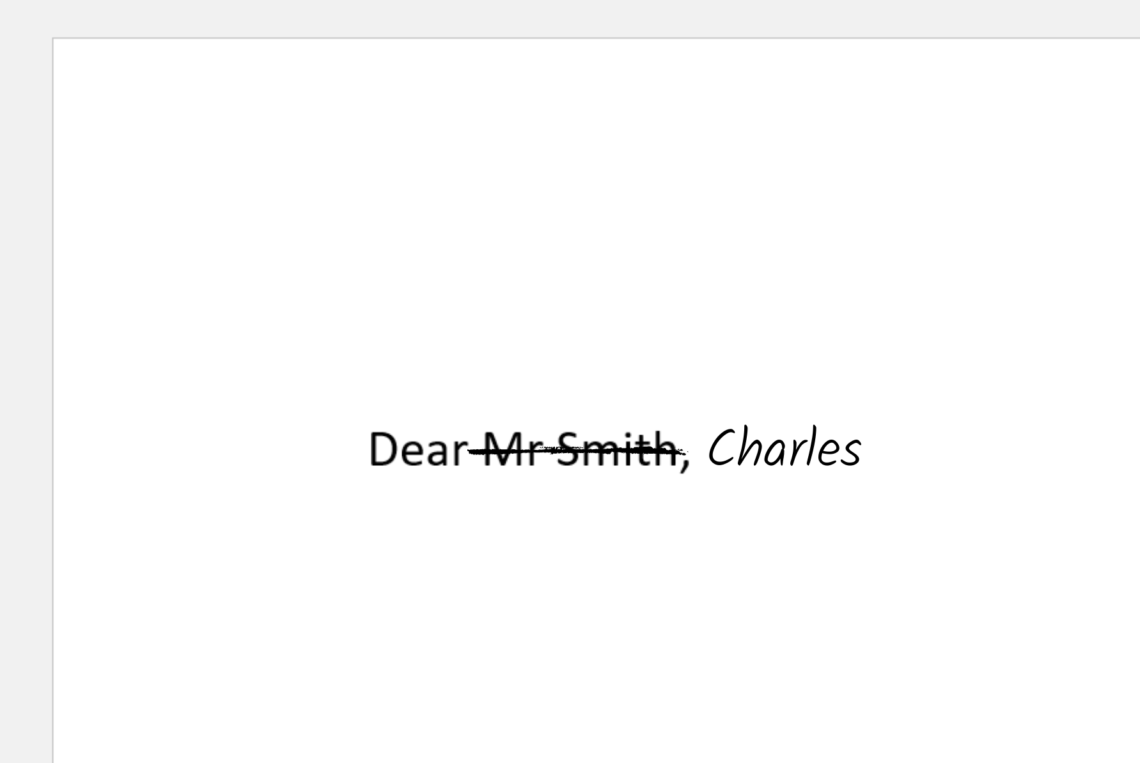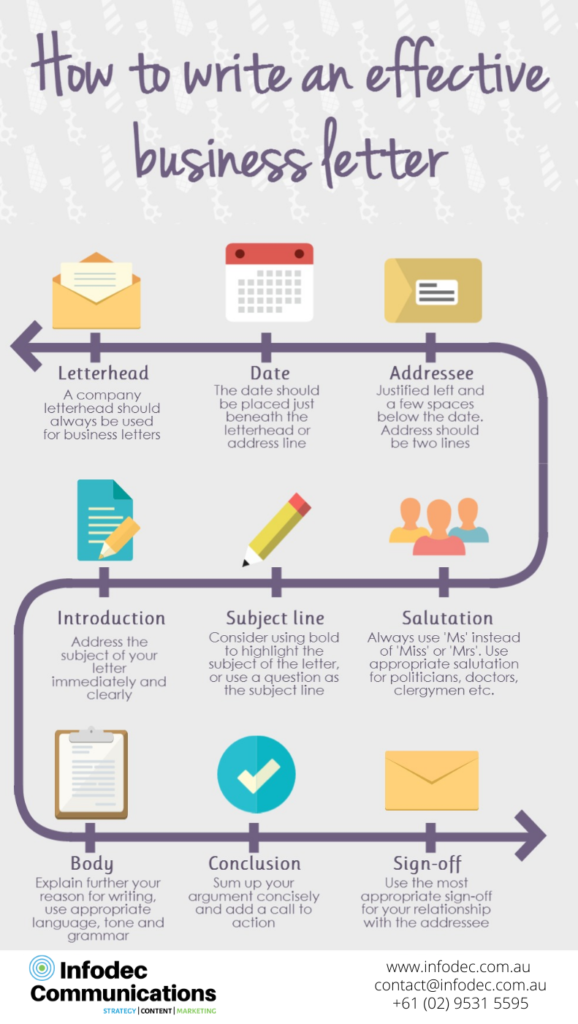
From Ned Kelly’s Jerilderie Letter to the letters the Women’s Suffrage League sent to the newspapers, which helped usher in equal voting rights, Australia’s letter writers have influenced public sentiment.
In the business world the formal letter has accomplished many goals, whether addressing grievances, setting up alliances, confirming contracts or informing the recipient of important news.
While written correspondence is now less formal, and in many instances, email is the chosen form of communication, the ability to compose a formal, persuasive letter is still of great value.
Common examples of letter formats important in the business world include:
- The cover letter
- The letter of enquiry
- The sales letter
- The resignation letter
- The letter of thanks
- The letter of complaint
- The claims letter
- The letter of apology
- The letter of invitation
Letter writing is a skill, and promoting action through words is genuinely reflected in the contents of a well written and formatted letter.
We have put together a guide that will help you write a letter that promotes action. Key steps include:
Consider your audience
By determining who you will be sending the letter to and for what purpose will dictate the best course of action. If a letter reflects good writing discipline and consideration, the content is much more likely to be received positively from the outset, increasing its persuasive power.
Steps to setting out your letter correctly
Your address or company letterhead
Businesses should always use company letterhead for letters.
If you need to send a letter that doesn’t require a letterhead, justify the sender’s address at the top of the page. Our preference is to explain your address to the right of the page, and it should run over two lines, street address and then on the second line, your suburb, state and postcode.
If your letter runs across multiple pages the letterhead only needs to be used for the first page.
The date
Dating a letter is essential, and the date should be positioned just below the company letterhead. If you are not using letterhead, it should be justified to a few spaces down on the opposite side of the page from your address.
Our preference for an address is the date, month and year, for example, 23 March 2020.
The addressee
The address of the recipient should also be justified left and positioned a few spaces below the date.
It is more effective to find out who you are addressing the letter to rather than just sending a blanket letter; for example, Mr John Smith is better than writing. Dear Homeowner.
The address should appear across three or four lines:
- The first line should be the addressee’s full name prefaced by their correct personal titles such as Mr, Mrs. Ms. or Dr if relevant.
- Your addressee’s formal work title, if relevant, should appear on the second line—for example, Managing Director, Director, Marketing Manager.
- The third line should include the street address
- The fourth line should include the suburb, state and postcode. We prefer to use capitals, for example, MIRANDA, NSW, 2228.
The salutation
Addressing the reader is an essential step towards having your message cut through the pack. Consideration for correct title use is vital in the writing of any letter.
MPs, mayors, religious clergy, defence force personnel and recipients of national or international awards and recognitions have formal titles.
Some examples include:
Hon. Mary Smith MP
His Eminence Cardinal Thomas Smith AC
General Sir Charles Edward Smith AK MC
It may also be best to use Ms when addressing a woman in a formal capacity. Miss and Mrs are titles that denote marital status and can be regarded as presumptive.
Some people also like to add a personal touch to their letters to someone they know by using a formal salutation like, Dear Mr Smith, and then put across through that name and write their first name in pen.

Do double-check the spelling of all names as incorrect spelling can create a poor impression from the start.
The subject line
Consider using a bold text subject line, for example, RE: Administrative Assistant Position. Or even a question like Do you want to ensure that your family is financially secure? To draw the recipient’s attention to the point and purpose of your letter.
The introduction
Be sure to address the subject of your letter immediately. Remember, the opening sentence is your chance to get straight to the point and secure their attention.
The body paragraphs
After you have established your subject, it is essential to explain the reason for writing further. It is vital to employ formal language with accurate grammar and punctuation. Read the letter back to yourself, have someone else read it to you or use the ‘read aloud’ function that comes with Microsoft Word. Remember, this is a formal way of communicating, and a non-emotive tone is best.
The conclusion & call to action
They’ve read this far, or they’ve skimmed to the end. It’s essential here, to sum up your argument in the most concise way possible. It doesn’t hurt to repeat your main objective and reasons – your conclusion must make the message stick.
A call to action is essential in the case that you would like a response. Suggest a possible course of action and encourage the addressee to maintain contact.
The sign-off
There are various sign-offs for different occasions, and the correct use for each depends on the context. For example:
- Yours faithfully is best used in the request of something, and don’t know the addressee.
- Yours sincerely is a good sign off for known addressees.
- Best regards are usually reserved for a close business contact or friend.
- Kind regards OR Warm regards is best used to sign off a letter of thanks or a more personal enquiry.
The shortened versions of the above – Best, Sincerely and Regards – are more suited to emails or informal correspondence.
Help out your recipient in cases where you want to avoid ambiguity and let the reader know if you are male or female – sign off Charlie Jones (Ms) or Marion Wayne (Mr), for example.
Sign your letter using a pen or a pre-saved e-signature.
Include your name and title at the bottom of the letter. If you are using letterhead, there is no need to repeat your company’s name in the signature as it is already covered at the top of the letter.
Common Abbreviations in letters
Although they may be associated with the typewriter era, certain abbreviations are still standard official correspondence, including:
Asap – as soon as possible
Cc – carbon copy (indicating the other people receiving the letter)
c/o – care of (temporary address or intermediary receiving the letter)
Enc. – enclosure (additional items are attached or enclosed with the letter)
per/pp. – per pro (signing for and on behalf of someone else)
ps. – postscript (adding an item after sign off)
PTO. – please turn over (indicating there is the following page)
RSVP – French for ‘Reply, if you please’ (especially to an invitation)
Note that punctuation tends to be minimal now – PTO rather than p.t.o.
Length
Try to keep your letter as brief as possible without losing the context of your message. One page is ideal for persuasive letters as it puts less demand on the reader’s attention span and avoids the risk of separate pages becoming lost. If that isn’t possible, try to keep your message to two pages.
Sending your letter
If you are posting a letter, the Australia Post guide details how to address the envelope correctly. You can read more about that here. If you are emailing your letter as an attachment, make sure that it is saved in PDF format rather than as a word document so that changes cannot be made to the letter, especially if you have signed it. If you are using a scanner, make sure that the letter’s final version is good.
It is often a good idea to send a hard copy of the letter and email it to the relevant person.

Get Infodec Communications to write a letter for you that promotes action
Digital communication has meant that the art of letter writing is often overlooked. But we know for a fact that a persuasive, well-written letter gets action.
Over the years, we have worked with a wide variety of businesses, writing business letters that have resulted in their ability to get responses from sales targets, members of Parliament, sponsors, VIPs and more.
Get in touch with us today to see how the correct letter can get the results you want for your business.
